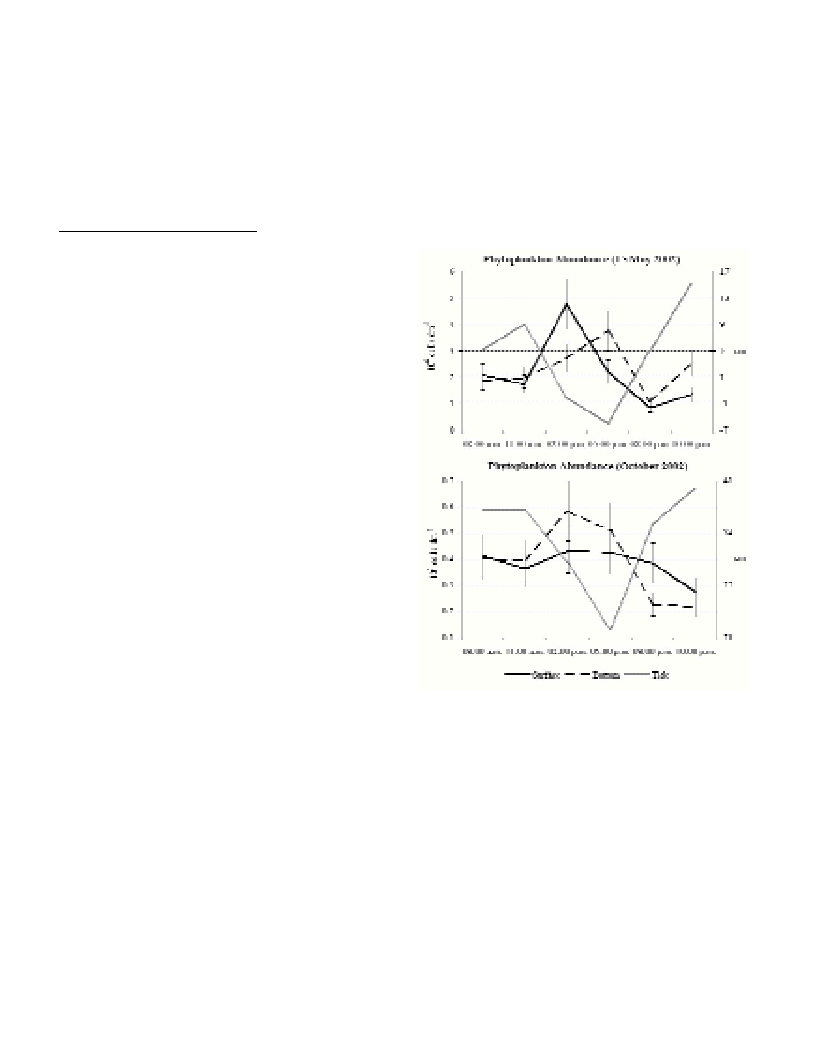PHYTOPLANKTON VARIATIONS IN A MEDITERRANEAN CHANNEL DURING A DIURNAL TIDE.
Facca Chiara
1*
and De Casabianca Marie-Luce
2
1
Department of Environmental Sciences, Venice, Italy - * facca@unive.it
2
CNRS-Cefe, UPR 9056, S.M.E.L., Sète, France
Abstract
The present study discusses phytoplankton abundance and diversity diel variations in the channel, which connects the Thau lagoon
(France) to the Mediterranean Sea. Abundance in surface and bottom samples, collected every three hours in May the 15
th
2002 and in
October the 22
nd
2002, with good windless weather conditions, displayed similar trends. Peaks occurred during the ebb tide, except for
the surface samples, collected in October, when the abundance remained almost constant. Pearson correlation revealed that tidal height
variations affected mostly phytoplankton diversity, enriching the number of species during ebb.
Key-words: phytoplankton, tide, lagoon
Rapp. Comm. int. Mer Médit., 37,2004
517
Introduction
Phytoplanktonic populations have a short life cycle and their
presence/absence can be affected by an high number of variables
(temperature, salinity, light intensity, nutrient availability…). To
investigate the weak tide current effects of on phytoplankton
abundance and diversity, a Mediterranean channel (Thau lagoon),
with slight tidal height variations (±15 cm, on average), was chosen.
The Thau lagoon has a wind-induced hydrodynamic pattern,
negligible freshwater inputs and the sea-lagoon exchanges occur
through the Sète channel [1], where sampling station is located. This
area is, moreover, affected by high nutrient inputs, above all nitrogen,
due to the farmed shellfish excretions and biodeposition.
Methods
Water samples were collected by means of a bucket and a Kemmer
bottle at the surface and at the bottom, respectively. Sampling
campaigns were carried out in May the 15
th
2002 and in October the
22
nd
2002 (two windless days), every three hours from 08:00 a.m. to
08:00 p.m. to comprise a diurnal tide. Moreover, samples were
collected around 10:00 p.m. to describe the dark condition.
Phytoplanktonic specific composition and abundance were
determined at light inverted microscope (Zeiss, Germany) according
to Utermöhl’s method [2]. Shannon diversity index and Pieolu
evenness were calculated.
Results
Marked abundance ?uctuations were observed in May the 15
th
(Fig.1). Surface and bottom samples displayed a similar mean value,
2.16 ±1.37 and 2.32 ±0.91 x 10
6
cells dm
-3
, respectively, but the
maximum and the minimum strongly differed. Surface community
was 0.84 x 10
6
cells dm
-3
at 08:00 p.m. and 4.76 x 10
6
cells dm
-3
at
02:00 p.m. (Fig. 1). Bottom community presented low abundance but,
also, low variations (between 1.06, at 08:00 p.m., and 3.76 x 10
6
cells
dm
-3
, at 05:00 p.m.). Some taxa were commonly widespread during
all day and the most abundant was nanoflagellates (spherical
?agellates, which size is less than 5 µm). During the ebb some species
(i.e. Nitzschia frustulumGrunow and Fragilariasp.) appeared,
favouring the increase of diversity.
In October the 22
nd
surface abundance remained almost constant,
varying between 0.27 x 10
6
cells dm
-3
, at 10:00 p.m., and 0.43 x 10
6
cells dm
-3
, at 02:00 p.m. In bottom samples abundance was higher
than in surface from 08:00 a.m. to 05:00 p.m. (Fig. 1). It reached
0.58x 10
6
cells dm
-3
in the early afternoon and, then, it dropped to
0.22 x 10
6
cells dm
-3
, in the evening. Nano?agellates were still the
most abundant taxa. During the ebb tide Dinophyceae abundance
increased and Pseudonitzschia heimiiManguin represented till the
10% of total phytoplankton community.
Pearson correlation highlighted that, in May, diversity and evenness
were significantly (p<0.05) affected by tidal height variations. In
October, on the contrary, Shannon index was indirectly correlated
with water temperature. No significant correlation was observed
between abundance and the considered physical parameters.
Bacillariophyceae, both pelagic and benthic species, were, in
general, more abundant during ebb than during ?ood tide. Pennate
diatoms, often common in benthic habitat, were more frequent in
bottom than in surface samples and they clearly characterised the ebb,
highlighting the strong in?uence of lagoon waters on channel.
Seawater effects on phytoplankton species were, instead, less evident.
References
1-De Casabianca M.L., and Kepel R.CH., 1999. Impact of dominant
winds on hydrological variables in a Mediterranean lagoon (Thau lagoon,
France). Oebalia, 25: 3-16.
2-Utermöhl H., 1958. Zur Vervollkomnung der quantitativen Phyto-
plankton-Methodik. Mitt. int. Verein. Limnol., 9: 1-38.

